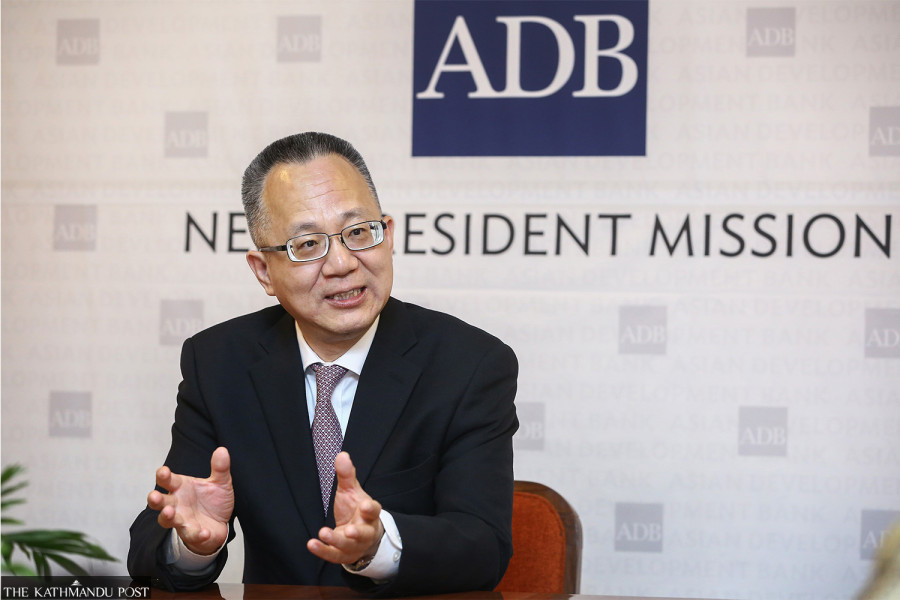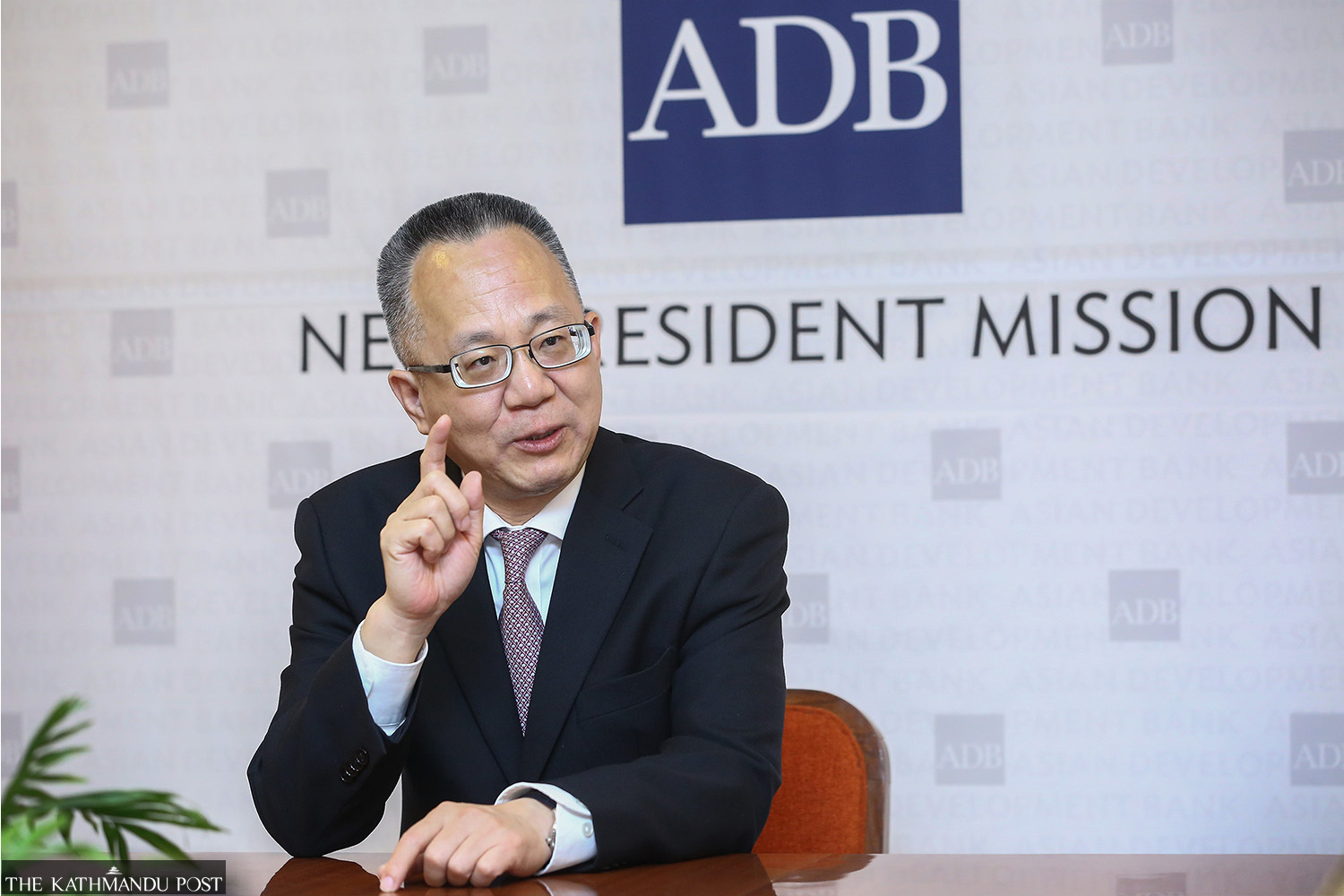Money
Nepal deserves global attention as a promising investment destination
Yingming Yang discusses a range of issues, including ADB’s support for improving Nepal’s business climate, agricultural productivity, supporting private sector investments and disaster risk management.
Sangam Prasain
Yingming Yang is the vice-president of the Asian Development Bank’s South, Central and West Asia regions. He joined ADB in January 2024. Yang is responsible for operations in the bank’s South Asia and the Central and West Asia departments. He is currently in Kathmandu to attend the Nepal Investment Summit. In an email interview with the Post's Sangam Prasain, Yang spoke on a range of issues, including ADB’s support for improving Nepal’s business climate, agricultural productivity, enhancing the skills of youth, supporting private sector investments, investing in hydropower, transport connectivity and digital development and supporting climate mitigation and disaster risk management. Excerpts:
You are here to attend the Nepal Investment Summit. What are your expectations from the summit?
I am delighted to be here in Nepal, and it is an honour for me to participate in the Nepal Investment Summit 2024. I would like to extend my congratulations to the government of Nepal for hosting this important event. Nepal is at a crucial juncture, welcoming investors and highlighting progressive changes that have improved the business climate in recent years. Nepal deserves global attention as a promising investment destination, and this summit provides an ideal platform to showcase the opportunities that Nepal has to offer to investors. Nepal has taken proactive measures to ensure key reforms are underway and these are crucial steps toward unlocking the full potential of the private sector. It is also important to ensure effective implementation for translating policies into tangible outcomes. Eventually, I hope the summit paves the path for greater investment mobilisation, from domestic and international investors. I think Nepal should institute a regular process of introducing reforms and being responsive to investor concerns.
How would you describe ADB’s relationship with Nepal when it comes to investing in developing countries?
Over the past five decades and more, dating back to 1969, Nepal and the ADB have worked hand in hand to address the country's most pressing development needs and improve the lives of its people. From building roads, and airports, and enhancing energy and water systems to supporting education, skills development, and agriculture, ADB has been a key partner in Nepal's development journey. We take immense pride in our partnership with the people and the government of Nepal. As of the end of last year, ADB's active portfolio in Nepal stood at around $3.6 billion, supporting a broad range of key sectors, including energy, transport, agriculture, water, urban infrastructure and services, rural development and natural resources and education. We are committed to scaling up our support to Nepal in partnership with the government, the private sector and development partners.
Nepal is due to graduate from its current status, as one of the world's least-developed countries, in 2026. This means Nepal will also lose benefits from certain preferential provisions laid out in different WTO agreements, including the official development assistance. What will be the ADB's role in facilitating Nepal's graduation process through the transition phase?
The fact that Nepal is set to graduate from the least developed country (LDC) category in 2026 underscores the progress made over the past decades despite numerous challenges, including political changes, natural disasters, and the Covid-19 pandemic. For this graduation to be sustainable, Nepal must focus on achieving inclusive and robust economic growth by enhancing productivity and competitiveness in the economy.
ADB is currently conducting a diagnostic study titled ‘Nepali Exports: Firm-level Evidence’, which will suggest policy recommendations to inform its new Country Partnership Strategy (2025–2029). The study will provide insights into fostering Nepal’s export growth and supporting the transition to a new growth model based increasingly on competitiveness, export diversification, and employment creation.
Under ADB’s country partnership strategy for Nepal, which we are currently developing in close alignment with the World Bank’s country partnership framework, ADB will facilitate Nepal’s transition to the developing country status. This will be achieved through measures such as improving the business climate, increasing agricultural productivity, enhancing the skills of youth, supporting private sector investments, investing in hydropower, transport connectivity and digital development, and supporting climate mitigation and adaptation, and disaster risk management.
Despite rapid poverty reduction, Nepal's development path is not helping it escape a low-growth trap. What should Nepal do to accelerate development, and achieve higher and inclusive economic growth?
While progress has been made in reducing poverty over the past two decades, Nepal's GDP growth has been moderate, averaging 4-5 percent annually. Productivity growth has been low, primarily due to reliance on remittance-dependent private consumption. The International Monetary Fund (IMF) estimates Nepal's long-term economic growth at just above 5 percent, which falls short of the 7 to 8 percent needed to transition to an upper-middle-income country, given its lower-middle-income status. To achieve growth, Nepal needs structural economic reforms. While the services sector has grown slightly, this growth hasn't translated into enough job opportunities, largely due to prevailing informal activities.
To expedite development, Nepal must enhance private sector competitiveness and global market integration. Foreign direct investment (FDI) has been minimal, constituting less than 1 percent of the GDP. Political stability, improved infrastructure, and consistent policy reforms are necessary to attract more FDI, particularly in manufacturing and services.
Beyond these, Nepal should prioritise the export promotion of IT services, tourism, and hydropower. Support from ADB and other development partners has improved the energy sector's reliability and sustainability, facilitating cross-border trade. Additionally, ADB's assistance in developing sustainable transport infrastructure and trade facilitation will reduce costs for firms, improve market access for people, and create more employment opportunities.

What is green financing? How will green finance help Nepal leverage its potential, particularly in renewable energy?
Green financing refers to financial instruments, investments, and mechanisms specifically designed to support environmentally sustainable projects or activities. These could include initiatives aimed at reducing carbon emissions, promoting renewable energy, improving energy efficiency, conserving natural resources, or mitigating climate change impacts. Green financing can take various forms, such as green bonds, green loans, green mortgages, and green investment funds. In Nepal, the government and private sector, supported by development partners, continue to invest substantially in hydropower, a renewable and green source of energy. However, access to financing remains a major constraint. Green finance mechanisms, such as green bonds, loans, and investment funds, can provide additional capital to develop renewable energy projects. This access to capital can help accelerate the deployment of renewable energy infrastructure, leading to increased energy generation.
It is expected that climate change will adversely affect Nepal’s biodiversity, human well-being, and economy. Is there any support ADB is extending to Nepal to mitigate disaster and climate change effects?
We commend Nepal for its comprehensive National Adaptation Plan and Nationally Determined Contribution. We recognise the government’s commitment to achieving a net-zero climate emission target by 2045. ADB’s operations in Nepal are aligned with these plans and targets. Furthermore, ADB’s operations in Nepal are aligned with Nepal's home-grown Green, Resilient, Inclusive Development (GRID) strategy, which is being supported by 16 key development partners.
Currently, ADB Nepal is preparing a GRID policy-based programme with a strong climate focus, expected to be approved in 2024. Additionally, there are several initiatives and technical assistance projects on climate change and disaster risk management. One of the main initiatives is the Building Adaptation and Resilience in the Hindu Kush Himalayas—Bhutan and Nepal, aimed at boosting the two countries’ ability to evaluate multi-hazard risks, improve multi-hazard risk management, and examine innovative finance strategies for climate-resilient investments.
Moreover, ADB is preparing a large-scale financing facility, the Green and Resilience Financing Facility, to help the government implement projects identified in the National Adaptation Plan. The goal of the facility is to raise $1 billion in highly concessional loans and grant financing. Globally, ADB aims to achieve $100 billion in cumulative climate finance using its resources between 2019 and 2030.
There are questions raised in the project financed by ADB. Large infrastructure projects in Nepal have been delayed even during times when the politics was stable. What’s the reason behind the delays in your assessment?
Delays in delivering large infrastructure projects are a common challenge in many developing countries. Broader governance and capacity issues, along with project-specific challenges, affect project effectiveness and efficiency. In Nepal, factors like fragile geology, natural disasters, remote locations, and limited working seasons add complexity beyond individual projects' control.
The transition to federalism has improved service delivery but poses challenges in devolving functions, functionaries, and funds. Timely project implementation requires strong, continuous project leadership with less frequent changes in staffing and adequate authority delegation. Involving project stakeholders from the outset is essential.
I firmly believe that leveraging new technologies can significantly improve project progress and alleviate implementation bottlenecks. Resolving issues like poor contractor performance and delays in land acquisition and permissions requires updating legal frameworks and digitisation of clearance processes. It's essential to address concerns such as contract management, environmental safeguards, and governance constraints to enhance project implementation and ensure the timely delivery of development results on the ground.
We appreciate the efforts of the government to address administrative and policy-level issues related to investment project cycle management. ADB has recently initiated a technical assistance project to enhance procurement efficiency and quality, improve contract management and execution tools, digitise environmental and forest cutting clearances, harmonise project readiness processes among ADB, the World Bank, and the government, and enhance interagency coordination.
In recent years, Nepal has been confronted with the phenomenon of brain drain. The number of youths leaving the country in pursuit of better opportunities in foreign lands continues to grow. In your view, what strategy should Nepal adopt to stop the brain drain?
The lack of adequate decent job opportunities in Nepal serves as a critical "push factor" for outmigration. Foreign employment emerges as an attractive alternative for those struggling to find jobs domestically. Most migrant workers have less than a secondary education and work in low-skilled and semi-skilled jobs abroad, with only a small percentage employed in professional or high-skilled roles.
While remittances contribute significantly to Nepal's GDP (accounting for about 22.7 percent in the fiscal year 2022-23) and play a crucial role in economic growth and poverty reduction, Nepal cannot solely depend on migration and remittances as primary economic drivers. These factors are highly contingent on economic and political conditions in host countries and mainly boost private consumption, leading to low productivity growth.
Nepal’s economic policy must promote sustainable and inclusive economic transformation that generates ample job opportunities. Currently, many youths are seeking employment abroad due to the lack of acceptable opportunities at home. To address this, Nepal should prioritise promoting safe migration by enhancing the skills of migrant youth, enabling them to secure better-paying jobs with improved working conditions in host countries, while also reducing the cost of remitting money back to Nepal. Moreover, in the medium to longer term, Nepal's development objectives should increasingly focus on investing in infrastructure, productive capacity, productivity growth, and job creation within the country.

What is your assessment of the progress that Nepal has made in infrastructure and development?
Nepal has made significant strides in expanding its infrastructure, but it still lags behind middle-income economies in Asia. For landlocked Nepal, roads serve as a critical lifeline, transporting 90 percent of passengers and goods. In recent years, extensive strategic road networks and rural roads have emerged, connecting previously remote areas to markets and the outside world. However, while developing new infrastructure, Nepal also needs to ensure better maintenance of the assets already created. Investments in improving roads and related infrastructure have been a crucial part of ADB’s strategy in Nepal to reduce poverty and support economic growth.
Through various projects and initiatives, ADB has supported the government of Nepal in enhancing infrastructure, including roads, airports, energy systems, water management, and urban facilities. These efforts aim to improve connectivity, promote economic growth, and enhance the overall quality of life for the people of Nepal. ADB is also assisting cities in Nepal in building climate-resilient infrastructure.
In recent years, Nepal has seen remarkable growth in its energy sector, with a surge in hydropower projects, policy initiatives, and cross-border collaborations aimed at meeting domestic energy needs and fostering regional energy integration. Just about fifty years ago, the electrification rate hovered around 2 percent. Half a century later, Nepal has witnessed incredible transformation. Over 95 percent of households now have access to grid electricity, and the country is exporting electricity to generate foreign currency. We are incredibly proud of our over five decades of partnership with the government of Nepal in the energy sector. Nepal has also witnessed significant advancements in telecommunications over the past decade, with mobile phone penetration reaching even the remotest locations. This has huge implications for the advancement of the digital economy.
What are the areas that ADB is seeking to support Nepal in the upcoming future?
ADB continues to support Nepal’s green, resilient, and inclusive development strategy by investing in infrastructure, improving access to basic services, and safeguarding poor and vulnerable populations from disaster and climate risks. Additionally, ADB will continue to collaborate with Nepal to strengthen institutional capacities for sector planning, enhance project readiness and implementation performance, and ensure sustainable asset management.
In our forthcoming CPS for 2025–2029, being developed jointly with the World Bank’s country partnership framework, ADB will prioritise fostering high, sustainable, green, and job-intensive economic growth in Nepal. This involves promoting the green economic transformation to create employment opportunities by enhancing the business climate, increasing agricultural productivity, improving youth employability, and supporting private sector investments.
Furthermore, ADB will maintain its commitment to investing in climate-resilient infrastructure, including renewable energy generation, transmission, and distribution, as well as enhancing national, provincial, and local transport connectivity and improving accessibility to urban infrastructure and services. Additionally, we will support enhancing the capacity of federal and sub-national governments and improving access to and the quality of school education, alongside strengthening local governance for education delivery. ADB remains dedicated to advancing gender equality and social inclusion, promoting digital development, and implementing comprehensive climate mitigation and adaptation strategies, including disaster risk management.




 13.12°C Kathmandu
13.12°C Kathmandu














